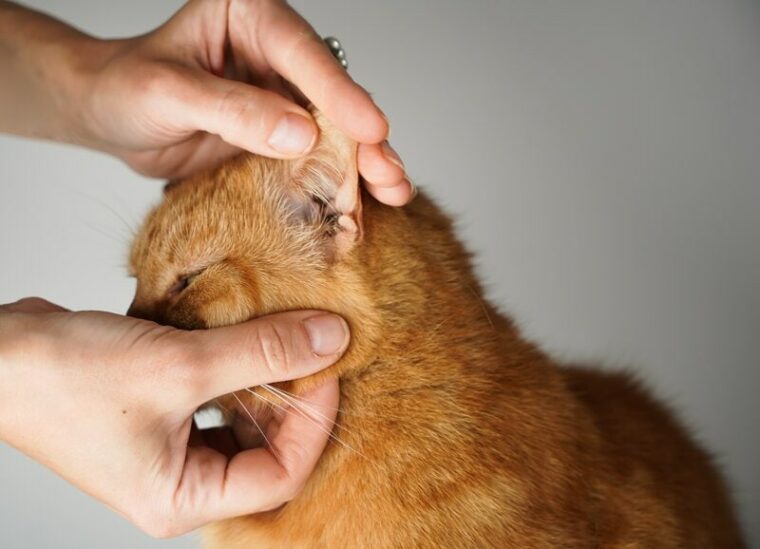
Ear infections are common in cats. And if they do not heal, they can get worse and worse. Most infections start in the ear canal and work their way further into the deep ear. Once the infection spreads to the inner ear it becomes much more complex.
Itchy, painful ears are not fun for anyone. Cats with ear infections are not happy campers and even though they may think that ear drops are the worst, they will feel better after. Read on to learn more about what causes ear infections and, more importantly, how you can help treat them at home with the vet’s medication.
What Are Ear Infections?
Ear infections are classified on how deep in the ear they go. The veterinary term for them is otitis, meaning ear inflammation. There are three types of ear infections affecting cats:
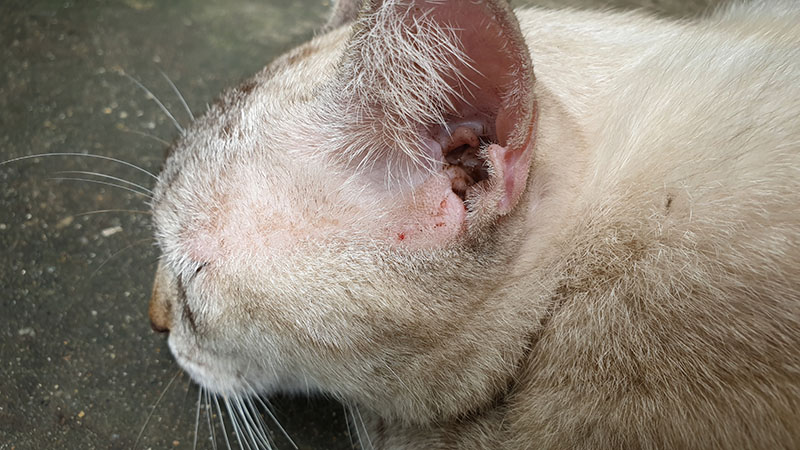
What Are the Signs of Ear Infections in Cats?
Otitis Externa
Inflammation of the ear canals can be painful, irritating, and itchy, so many cats will bother their ears and shake their heads. Signs that your cat might have otitis externa include:
Otitis Media
Infection of the middle ear usually starts as an infection of the outer ear that does not heal. Most cats will have signs of otitis externa and then, added on top, signs of otitis media, as follows:

Otitis Interna
The most severe, otitis interna will have signs of the other stages of ear infection but then will also have signs of neurological malfunction, including the following:
To explain some of the strange signs seen with otitis media and interna: There are nerves that run right alongside the inner ear, and the inflammation associated with otitis media/interna disrupts these nerves so that the face, eyes, and balance can all be affected. This results in the strange and dramatic signs listed above.
What Are the Causes of Ear Infections?
Ear infections are caused by yeast and/or bacteria. Both thrive in warm and moist environments, and the ear is a lovely spot for them to flourish—especially if the ear is already dirty, blocked with ear wax, or has moisture stuck in the canal.
They can also be triggered by external parasites. Ear mites can cause yeast and bacteria to infect the ears. Even fleas, ticks, and other bugs on the skin can leave the ears vulnerable.
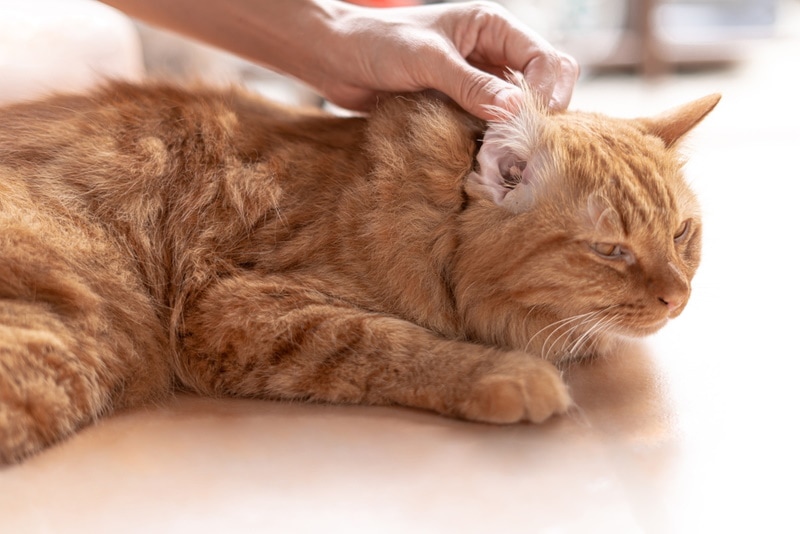
How Do I Care for a Cat With Ear Infections?
Cats with otitis externa usually need ear drops to fight the infection. The drops are often a combination of antifungal medication (to fight the yeast), antibiotics (for the bacteria), and may or may not include a mild steroid (to help decrease inflammation and pain).
Your vet may just give you ear drops, or they may give you instructions to wash their ears too. The two procedures are pretty similar, get the liquid in the ear at all costs, but they do differ in goals.
It can be an adventure getting ear drops into your cat. Especially after they learn what it is. The following are some tips and tricks that might help.
How to Apply Ear Medication on Cats: Step-By-Step Process
When applying medicated drops, the goal is to get the drops in and keep them in there. Do not just drop the liquid into the ear and let go. Instead, if you slowly introduce the nozzle against their ear and slowly drip it in, and then give them a nice ear rub, they might enjoy it more and might be more inclined to remember the nice ear rub afterward.
Here are some steps to follow:
1. Hold your cat gently in your lap or have a friend help hold them

Make sure the dropper is primed and ready to squirt. You don’t want to have to pump it or shake it once it is in the ear. You also do not want the plastic dropper to go deep into their ear; you don’t want it to come anywhere near the ear drum. But you do want the liquid to go all the way down.
2. Put the liquid just inside the entrance to the ear canal
Look at and learn the anatomy of their ear and find the canal. They have lots of folds and bumps. Make sure you know exactly which folds make up the ear canal and place the drop right there at the entrance of the ear canal.
It is easy to place it in an outer fold instead of the canal, which does not do anything. The medication does not get to where it needs to go—down the ear canal. The ear canal is usually closer to the nose and angled more down and forward than most people guess.
3. Once dropped in, rub the medication into the ear
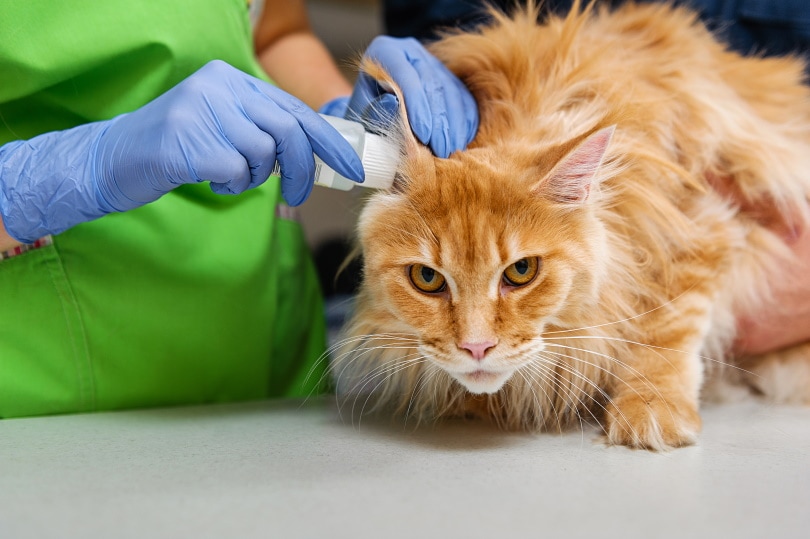
Fold the ear flap over the ear, close it off, and then rub the ear between your fingers. You can usually feel the ear canal through the skin. Do not poke the liquid down the canal with your finger. Instead, close the ear flap and rub the canal between your fingers, working it down like a toothpaste tube.
Do not panic when the medication gets all over their ear flap, their cheek, or face. It happens and is normal. If there is some medication outside the ear, hopefully, some of it is getting inside.
4. When in doubt, put more medication in
It is hard to OD on ear drops. And if you think you didn’t get it, try again. Wipe away excess medication on the outside of the ear canal if needed. Do not get it in their eyes or mouth—that’s really the only way it might cause problems.
How to Wash a Cat’s Ears: Prevention Is Better Than the Cure
When washing the ears, the goal is to get the cleaning liquid into the ear canal and then back out again. As it comes back out, it carries with it dirt, wax, yeast, and bacteria, so all that gunk needs to be wiped away.
NOTE: Do not use anything except dog and cat ear wash. Rinsing the ears with water usually creates more problems. Do not use Q-tips; only use cotton balls. Only stick them down the ear canal as far as your finger gently can go to avoid that eardrum.
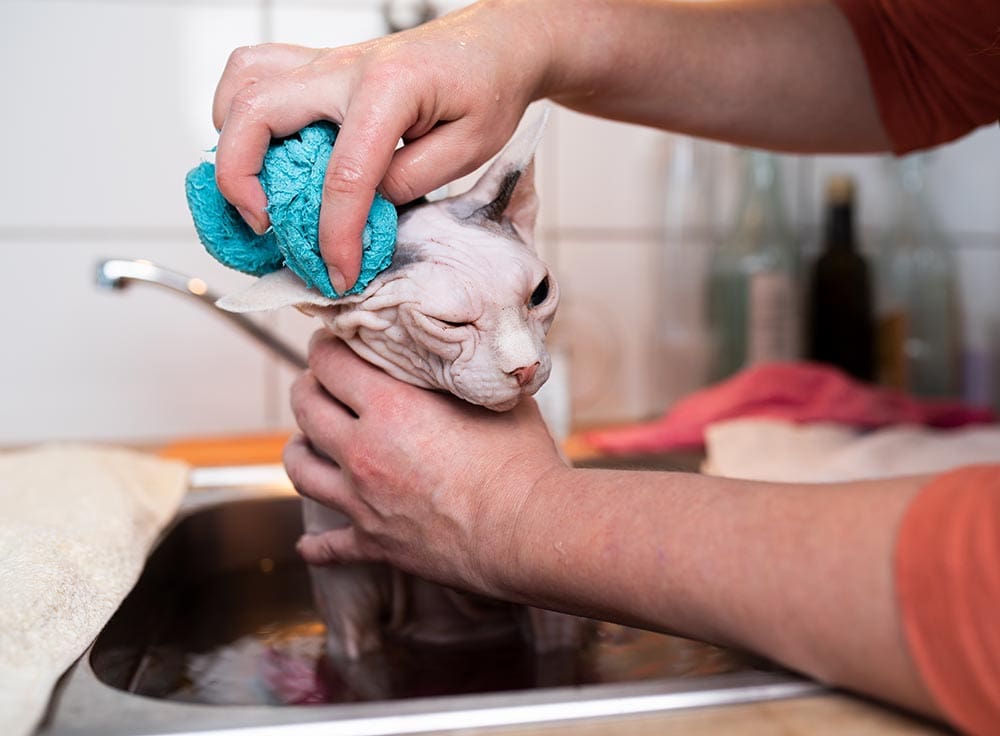
1. Gently drip the liquid directly into the canal.
Position the nozzle against the opening of the canal, do not go into the canal with the nozzle (to avoid coming close to the eardrum). You also don’t want to close off the ear canal with the nozzle or blast the liquid into the canal with lots of pressure. The eardrum is very fragile. Plus, your cat will hate it.
2. Close the ear flap and rub the canal with your fingers.
Remember what to do when using medication in your cat’s ears? It is the same here. Do not poke the liquid down the canal with your finger. Instead, close the ear flap and rub the canal between your fingers, working it down like a toothpaste tube.
3. Release the ear and let your cat shake its head.
When they shake their head, they will whip out the ear wash and all the gunk with it.
4. Use a soft, clean cotton swab that is damp with the cleaning solution and wipe away all the gunk.
Keep wiping with new, clean swabs until they do not pick up any more gunk. Make sure you get in between all the folds and between the creases of the ear flap; these pockets of gunk hide the bacteria and yeast. Creating protected pockets of infection that need to be wiped away.
5. Rinse and repeat
Fill the ear canal with liquid, rubbing it around, and letting them shake it out until you feel you have made a dent in the gunk. It might take a couple of times (days) to get the ear canal clean. With each cleaning, more gunk will get dislodged and come out.
Frequently Asked Questions (FAQs)

What if I can’t get the medication into my cat’s ears?
If you absolutely cannot get the drops into their ears, do not be embarrassed. It happens all the time. And we do understand. Some cats will just not allow it.
But do tell your vet. There are other options. Sometimes oral medication may be better, or there are medications that can be placed into their ears by the vet that last a long time.
I have reached the end of the prescription but how do I know if the ear infection is gone?
It is very common for ear infections to not fully heal by the time the medication runs out. If you suspect this is the case, bring them back to the vet or call for more medication.
Sometimes it just needs more time, but sometimes the infection has changed, so the bacteria or yeast is resistant to the medication. If the infection is resistant to the medication, it will not kill it, and the vet will need to do further testing to determine which medication will work.
Conclusion
Patience, persistence, and technique are the key to ear infections. Do not give up. If one method doesn’t work, try another. Use other people in the house to help. And ask your vet for other options if you’re at a dead end. We get it; we wrangle angry cats every day. We know it’s a tough job convincing them it’s for their own good.
But, hopefully, in an ideal world, this article helps you get that medication into the right ear fold and down that canal eviscerating that pesky yeast and bacteria.
Featured Image Credit: Simxa, Shutterstock






